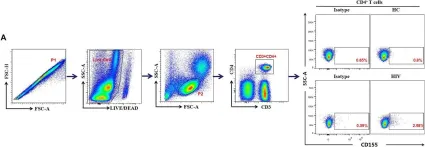The CD155/TIGIT axis can be co-opted during immune evasion in chronic viral infections and cancer. Pancreatic adenocarcinoma (PDAC) is a highly lethal malignancy, and immune-based strategies to combat this disease have been largely unsuccessful to date. We corroborate prior reports that a substantial portion of PDAC harbors predicted high-affinity MHC class I-restricted neoepitopes and extend these findings to advanced/metastatic disease. Using multiple preclinical models of neoantigen-expressing PDAC, we demonstrate that intratumoral neoantigen-specific CD8+ T cells adopt multiple states of dysfunction, resembling those in tumor-infiltrating lymphocytes of PDAC patients. Mechanistically, genetic and/or pharmacologic modulation of the CD155/TIGIT axis was sufficient to promote immune evasion in autochthonous neoantigen-expressing PDAC. Finally, we demonstrate that the CD155/TIGIT axis is critical in maintaining immune evasion in PDAC and uncover a combination immunotherapy (TIGIT/PD-1 co-blockade plus CD40 agonism) that elicits profound anti-tumor responses in preclinical models, now poised for clinical evaluation.
Copyright © 2021 Elsevier Inc. All rights reserved.
Product Citations: 2
In Cancer Cell on 11 October 2021 by Freed-Pastor, W. A., Lambert, L. J., et al.
-
FC/FACS
-
Homo sapiens (Human)
-
Cancer Research
-
Immunology and Microbiology
In Frontiers in Immunology on 27 October 2018 by Yin, X., Liu, T., et al.
Natural killer (NK) cells are important for maintenance of innate immune system stability and serve as a first line of defense against tumors and virus infections; they can act either directly or indirectly and are regulated via co-operation between inhibitory and stimulatory surface receptors. The recently reported inhibitory receptor, TIGIT, can be expressed on the NK cell surface; however, the expression level and function of TIGIT on NK cells during HIV infection is unknown. In this study, for the first time, we investigated the expression and function of TIGIT in NK cells from HIV-infected individuals. Our data demonstrate that the level of TIGIT is higher on NK cells from patients infected with human immunodeficiency virus (HIV) compared with HIV-negative healthy controls. TIGIT expression is inversely correlated with CD4+ T cell counts and positively correlated with plasma viral loads. Additionally, levels of the TIGIT ligand, CD155, were higher on CD4+ T cells from HIV-infected individuals compared with those from healthy controls; however, there was no difference in the level of the activating receptor, CD226, which recognizes the same ligands as TIGIT. Furthermore, TIGIT was found to specifically up-regulated on CD226+ NK cells in HIV-infected individuals, and either rIL-10, or rIL-12 + rIL-15, could induce TIGIT expression on these cells. In addition, high TIGIT expression inhibited the production of interferon-gamma (IFN-γ) by NK cells, while TIGIT inhibition restored IFN-γ production. Overall, these results highlight the important role of TIGIT in NK cell function and suggest a potential new avenue for the development of therapeutic strategies toward a functional cure for HIV.
-
FC/FACS
-
Immunology and Microbiology
In Front Immunol on 27 October 2018 by Yin, X., Liu, T., et al.
Fig.3.A

-
FC/FACS
-
Collected and cropped from Front Immunol by CiteAb, provided under a CC-BY license
Image 1 of 1
